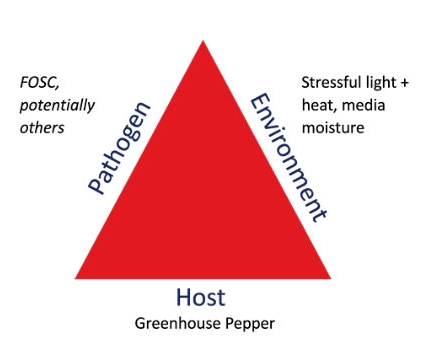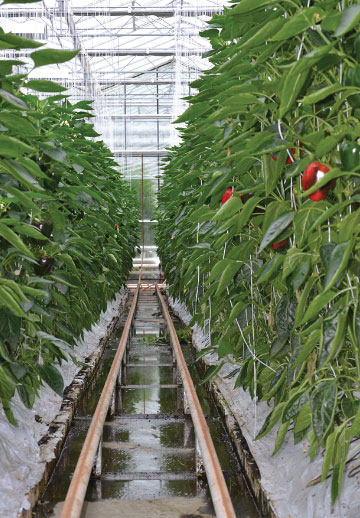4/30/2025
Getting to the Root of Novel Greenhouse Pepper Wilt
Dr. Andrew C. Wylie

A novel greenhouse pepper wilt has caused significant losses in the last few years, with the first confirmed cases in Ontario in 2022. By 2023, reports increased from Ontario, British Columbia and the Netherlands. In 2024, approximately 400 acres were lost to the disease in Ontario alone, leading to concerns about pepper supply.
Left: Ripening greenhouse pepper.
The disease seems to be associated with Fusarium oxysporum, although much remains unclear about how Fusarium is causing the disease.
“Fusarium wilt is a global issue that greenhouse growers in Ontario are certainly not exempt from,” said Daniel Terlizzese, Research, Innovation & Plant Protection Lead at Ontario Greenhouse Vegetable Growers (OGVG). “OGVG and its members are coordinating research and investing in new technologies to mitigate the impact. Our multifaceted strategies look promising to combat the disease.”
Understanding pepper wilt
Two central paradigms in plant pathology, the plant disease triangle and Koch’s postulates, can help us understand the novel pepper wilt. The disease has been consistently correlated with the presence of some members of the Fusarium oxysporum species complex (FOSC), a large group of related Fusarium species—some of which can cause disease. Fusarium oxysporum is prevalent in greenhouse systems, but typically didn’t cause severe disease in the past. Nonpathogenic F. oxysporum has even been used as a biological control organism, as it occupies finite resources and sites that otherwise could be exploited by pathogenic members of this species.
In the past, Fusarium disease of greenhouse peppers typically showed up as stem and root rot caused by Neocosmopara solani (formerly Fusarium solani) and internal fruit rot caused by other Fusarium species. In the novel pepper disease system, it seems that under the right conditions some member of the FOSC will exploit the opportunity to cause crown and root rot disease. This was historically the domain of various Pythium and Phytophthora species.

Defying the Disease Triangle
The Disease Triangle concept divides the necessary conditions for a plant disease into three aspects: a susceptible host plant, the presence of a plant pathogen and a favorable environment.
Susceptible host: This pathosystem is difficult to reproduce in its entirety. This complicates efforts to screen varieties to determine if any carry resistance to this disease or if all are equally susceptible.
Pathogen presence: The disease appears in the presence and the absence of several different pathogens, including the Fusarium oxysporum species complex, oomycetes, viruses and potentially bacteria.
Favorable environment: This includes the environmental conditions within the greenhouse, such as high light and temperature levels in spring, as well as the environment in the rootzone. The disease has presented both with and without extremes of light and temperature. Additionally, it’s been found to affect crops grown in both rockwool and coco.
Confusing Koch’s postulates
Nested within the pathogen aspect of the Disease Triangle we have Koch’s postulates—a set of principles that provide a clear set of conditions that, when met, can help infer that a microbe actually is causing a given disease. Formulated in 1884, they’re still widely used today in plant pathology, although they don’t work well for viruses and unculturable organisms. The pepper wilt system at hand also tests the limit of this framework.
Koch’s postulates vs. pepper wilt:
- Microbe must be present in diseased tissues—Condition mostly met, but the exact organism varies.
- Microbe must be isolated and grown in culture—Several likely candidates have been isolated.
- Purified microbe must cause disease in healthy plants—Isolated organisms have been variable, and under the right experimental conditions, it’s possible to create disease symptoms using weak pathogens. Strong pathogens can also lose their ability to infect plants during the experimental process.
- Same microbe must be re-isolated from diseased plants—This has been done, but previous caveats apply.
The disease kind of meets categorization efforts, but it’s not a slam dunk. In addition to FOSC members, Pythium, Phytophthora and other pathogens have been found in association with the disease. Bacteria and viruses could also be involved. Given the worldwide prevalence of the Tomato Brown Rugose Fruit Virus (ToBRFV), the involvement of this virus in pepper disease induction will be an important factor to rule out as peppers are an alternate host for the virus. The L-gene resistance to ToBRFV that pepper varieties carry has been shown to break down at high temperatures. Therefore, more work remains to be done to determine if this virus is present in pepper crops affected by pepper wilt and if it’s contributing to the onset of this disease. Until all of the important players are confirmed in this system by more fully characterizing the microbiome of diseased and healthy plants, and consistently reproducing the disease, the exact nature of pepper wilt remains an enigma.
Research on pepper wilt
At the Canadian Greenhouse Conference in October 2024, Agriculture and Agri-Food Canada’s Dr. Geneviève Marchand presented research results on the novel pepper wilt that she’s been performing in conjunction with Cara McCreary, Greenhouse Vegetable IPM Specialist with the Ontario Ministry of Agriculture, Food & Agribusiness (OMAFA). Sampling many commercial greenhouses over three years of pepper disease led to confusing results. Although the Fusarium oxysporum species complex was present in most samples, it wasn’t universally found and wasn’t consistently the same when analyzed.
Other pathogens were also present in many cases. Dr. Marchand performed research on Thiram, Posterity, Medallion, RootShield Plus and Asperello with mixed results due to co-infection with Pythium—an interesting parallel to the situation in commercial greenhouses. In a recent presentation, Cara compared closing in on the root of this issue to finding a needle in a haystack. Her research into Posterity (pydiflumetofen) in an infected greenhouse also led to promising, but mixed results, as the greenhouse  plants were already heavily infected when the trial began. Current trials at Vineland Research and Innovation Centre (Vineland) are also examining a variety of factors that could be contributing to the disease, with results expected in the coming weeks.
plants were already heavily infected when the trial began. Current trials at Vineland Research and Innovation Centre (Vineland) are also examining a variety of factors that could be contributing to the disease, with results expected in the coming weeks.
Right: Fusarium sp. micro- and macroconidia, conidiophore.
Correlation and causation
While the presence of FOSC hasn’t been conclusively linked to the occurrence of the pepper wilt disease, it has been found in the majority of cases. In the absence of a convincing alternative, this fungus does seem to be a good target for management. Dr. Marchand’s experiments and other research have shown that Fusarium isolates from diseased plants can cause disease, indicating that pathogenic Fusarium species are involved. However, when a diagnostic lab test indicates the presence of Fusarium oxysporum, this may or may not indicate whether this microbe is pathogenic, as Fusarium oxysporum stretches all the way from beneficial fungus to pathogen. Even in lab experiments it can gain and lose the ability to cause disease, making this fungus tricky to work with.

Hedging educated guesses to manage pepper wilt
Promising strategies to prevent and manage this still somewhat uncharacterized disease aren’t novel and thrilling, but are nevertheless essential.
“Water management is key to achieve a healthy root zone” said James Toivonen, Lead Grower, Greenhouses at Vineland.
Left: Greenhouse pepper row with standing water. Photo courtesy of Andrew Wylie.
Paying additional attention to slab moisture content will aid in preventing root rots, regardless of whether they’re caused by FOSC, Pythium, Phytophthora and many other pathogens. Fungicides, biofungicides and disinfecting irrigation water should be helpful, but won’t work well if slabs are waterlogged and general greenhouse sanitation isn’t prioritized. Water management is paramount regardless of whether coco or rockwool slabs are used for growing; the disease can affect peppers grown in both media types. Sanitation is especially important when targeting Fusarium, which can form chlamydospores (which are resistant to disinfection), as well as abundant conidia, which spread readily through greenhouse air. Disease onset often occurs during rapid increases in spring light levels. Smoothing out plant stress due to light and heat is likely to help reduce the rapid development of this disease.
Future research directions
Once the novel pepper wilt disease system is better characterized, a wealth of applied research directions open up, such as variety, environmental and product efficacy trials, which could rapidly lead to practical solutions. Given the complexity of the disease system at hand, a data-driven approach taking into account greenhouse environmental data coupled with high throughput biological and chemical data sources could be a fruitful near-term approach to elucidate the conditions that lead to the onset of this disease. Trialing resistant varieties or rootstocks would potentially close the disease triangle.
Conclusion
Much research remains before we fully understand pepper wilt and can effectively monitor for, prevent or control it. Work is in progress on several fronts and hopefully in the coming months we’ll be able to fill in the blanks outlined above, clarify the root cause and develop reliable management methods for this mysterious disease. In the meantime, growers are treading water with traditional strategies to reduce root rots and should focus on proactive water management, crop stress reduction and monitoring for early symptoms.
Dr. Andrew C. Wylie is Research Scientist – Plant Pathology at Vineland Research and Innovation Centre.